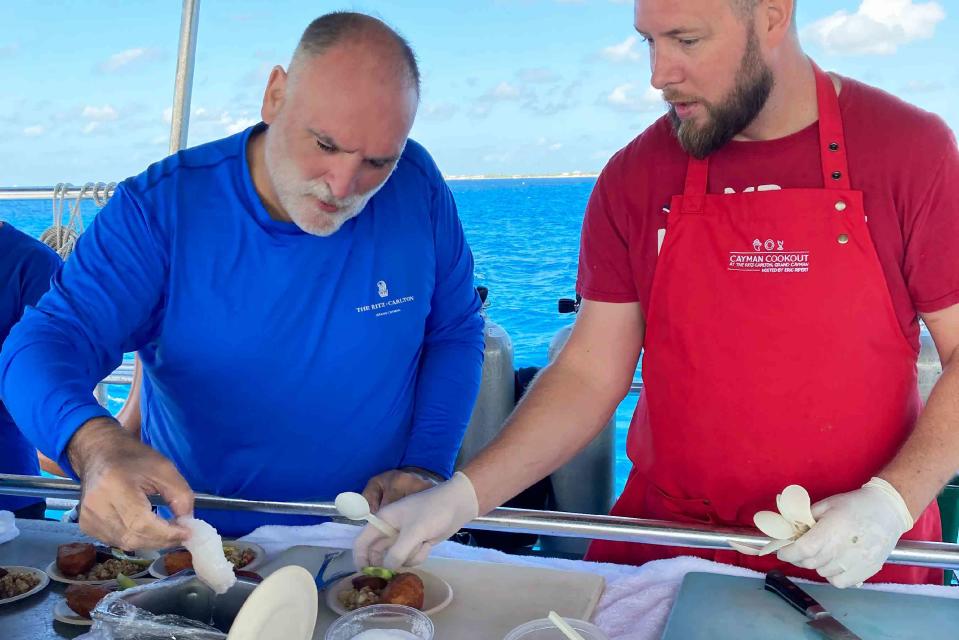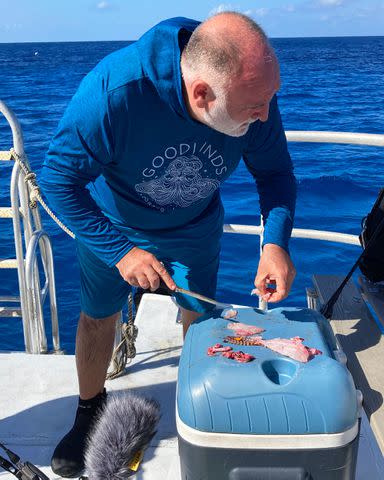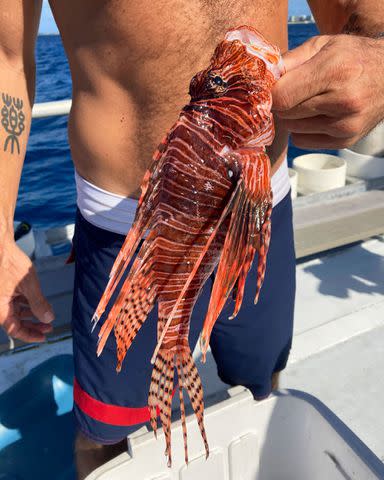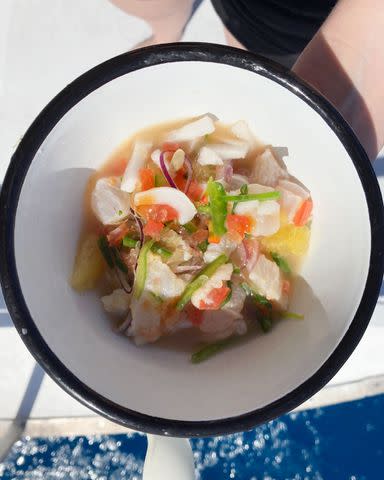José Andrés Wants You to Eat More Lionfish
- Oops!Something went wrong.Please try again later.
This beautiful striped fish is an invasive species that threatens marine ecosystems. It's also delicious.

José Andrés might have more energy than anyone on the planet. The chef and humanitarian manages to balance hands-on work with his nonprofit World Central Kitchen, promoting his latest TV show, and running a restaurant empire all at once. I met Andrés at 8 a.m. on a boat in the Cayman Islands — we were both there for The Ritz Carlton, Grand Cayman’s Cayman Cookout — and his energy was boundless. As we prepared for our expedition and looked out over the crystal blue Cayman water, the chef eagerly greeted everyone while expounding on our mission for the day: to spear some lionfish.
Andrés is as passionate about culling lionfish as he is about all his other projects, and for good reason. These beautiful, striped, and spiny fish are a notorious invasive species that pose a great threat to the biodiversity and marine ecosystems of Atlantic coastal waters, including coral reefs.
Andrés doesn’t just enjoy scuba diving and hunting for lionfish (although after a few hours with him, it’s clear he loves that part too), but he’s also working to raise awareness about lionfish as an invasive species, in part by encouraging people to help reduce invasive lionfish populations. As he explained while we jetted out to our first dive site, one of the easiest ways to do this is simply by teaching people how delicious lionfish is — the more people want to eat it, the more motivated divers are to hunt the fish.
Related:José Andrés Will Take You on a Tour of Spain in New Travel Series

Merlyn Miller
Lionfish are very difficult to catch on a typical fishing line and hook, and they’re also covered in eighteen venomous spines, which leave a painful sting on human skin. So, one of the most common methods is spearfishing, which is exactly what it sounds like, but to do this you need to be both scuba-certified and, at least in the Cayman Islands, licensed to cull lionfish. Since I am neither of those things, I spent my time snorkeling and sipping Diet Cokes on the boat while Andrés, his daughter Inés, and a few other experienced divers jumped into the water to spear some lionfish.
After their first round of diving, our lionfish hunters came up empty. Andrés noted that they’d only seen a few smaller lionfish, which are more difficult to spear — but this is ultimately a good problem, because it means people are killing the adult fish. We jetted off to another potential dive site (one that included a sunken ship!), and an hour later the divers surfaced with some freshly speared lionfish.

Merlyn Miller
When culling lionfish, you need a special container to hold each fish after it’s been caught; this protects the diver from being stung while they continue to hunt. There are a variety of options for holding speared lionfish, but the ones our cohort used were large, clear plastic jugs with a funneled opening — they looked similar to an office water cooler. These containers also made it easy for Andrés and his colleague on board, local chef Thomas Tennant, to pick up the fish without being stung.
Related:What It’s Like to Eat and Drink on a Luxe, Tiny Private Island

Merlyn Miller
Tennant works with lionfish often, and I watched him adeptly slice off all of their venomous spines in seconds. He and Andrés took turns cleaning lionfish on top of an ice chest on board, and then immediately handed us pieces of fresh, raw fish, placed on top of a slice of lime and seasoned simply with salt water from the ocean (which Andrés notes is the best seasoning). While lionfish might look pretty wild, they taste very pleasantly mild. It’s a flaky, white fish with a moderately firm texture, and a slightly buttery flavor that many people compare to mahi mahi. And it is absolutely delicious when enjoyed simply with some acid and salt.
Andrés prepared fresh lionfish ceviche for me on a boat, and few food experiences (or sentences) will ever be as humbling as that. I watched him taste every ingredient before adding it to the bowl of ceviche, no recipe needed; this was something he’d done and improvised a thousand times. The two chefs joked back and forth while they sliced lionfish and squeezed citrus, yielding one of the most incredible ceviches I’ve ever had.

Merlyn Miller
Lionfish firms up a little bit more as it sits in acid, and the buttery, mild fish was perfect for pairing with fresh coconut, jalapeño, Valencia oranges, red onion, and lots of tart lime juice. My main takeaway from that morning in the Cayman Islands wasn’t a specific method for preparing lionfish, but rather something much more straightforward; we should all be eating more of it.
Related:The Best Fish Fillet Knives for Every Type of Task
When restaurants put lionfish on a menu, and when customers choose to eat it, it creates a chain of demand that keeps people hunting and consuming lionfish — and the more lionfish we eat, the better. So if there’s one thing José Andrés wants you to know about lionfish, it’s this: When it’s on the menu, order it.
For more Food & Wine news, make sure to sign up for our newsletter!
Read the original article on Food & Wine.

